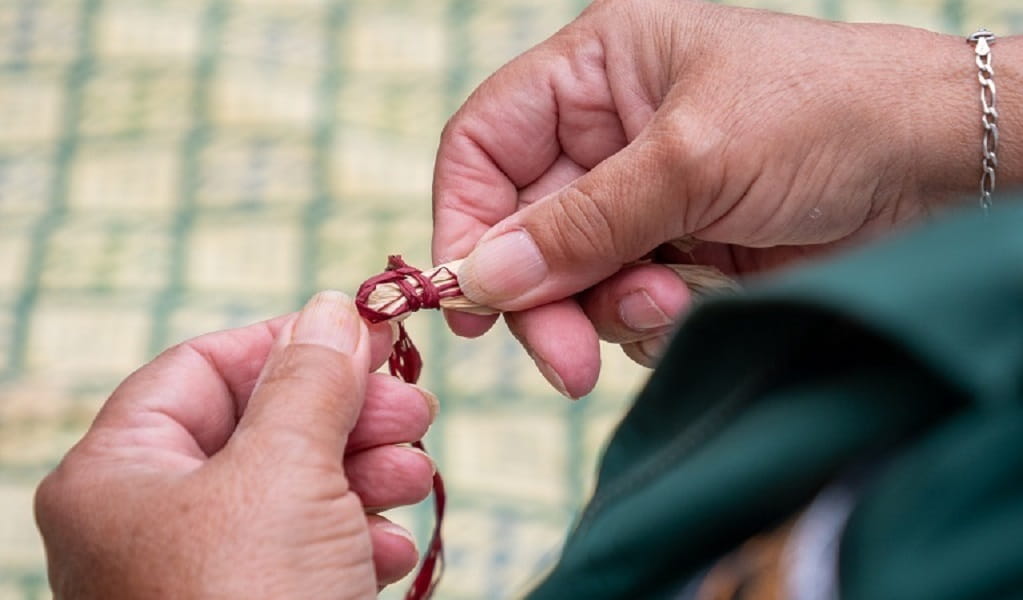Traditional weaving workshop: Killalea
Killalea Regional Park
Overview
Join this weaving workshop at Killalea Regional Park these school holidays. It's a great introduction to Aboriginal culture. You'll have the privilege of being taught by a senior Aboriginal NPWS guide.
- When
Wednesday 9 October 2024, 10.30am to 12.30pm
- Where
- Killalea Regional Park
- Accessibility
- No wheelchair access
- Grade
- Medium. Suitable for adults and children 10 years and older.
- Price
-
Adult/child $25 per person
- Meeting point
- Meet at the grassed area in front of the Farm Kiosk (Frasers Headland).
- Equipment
provided - Yes
- What to
bring - Hat, sunscreen, sturdy shoes, drinking water, snacks
- Bookings
- Bookings required. Phone 1300 072 757 for more information or book online.
Visit Killalea Regional Park, between Shellharbour and Kiama, and learn how to weave with grasses, reeds and natural materials. After you’ve honed your skills, you’ll have the opportunity to weave your own souvenir to take home with you.
As you explore your creative side, your guide will share how Aboriginal women weave baskets, carry bags and other items for daily use. You’ll discover how these ancient skills and practices carry a strong cultural connection for local Aboriginal women.
All material will be supplied on the day.
Wear enclosed shoes, a hat and sun cream. Bring drinking water and a snack.
Local alerts
For the latest updates on fires, closures and other alerts in this area, see https://www.nationalparks.nsw.gov.au/things-to-do/events/traditional-weaving-workshop-killalea/local-alerts
Bookings
- National Parks Contact Centre
- 7am to 7pm daily
- 1300 072 757 (13000 PARKS) for the cost of a local call within Australia excluding mobiles
- parks.info@environment.nsw.gov.au
Operated by
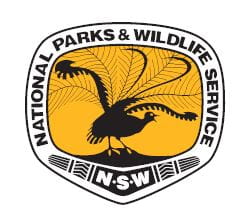
- NSW National Parks & Wildlife Service
Park info
- in Killalea Regional Park in the South Coast region
Visitor info
All the practical information you need to know about Traditional weaving workshop: Killalea.
Getting there and parking
Killalea Regional Park is located between Shellharbour and Kiama on the South Coast.
To get there from Sydney or Wollongong:
- Drive south on the M1 Highway.
- Exit onto Shellharbour Road and drive for 750m.
- Turn right onto Dunmore Road and drive for 700m.
- Turn left onto Buckleys road.
- Take the next left onto Southern Cross Boulevard and drive for 450m.
- Turn right onto Killalea Drive and continue to the park.
To get there from Shellharbour:
- Drive southwest on Shellharbour Road.
- Turn left onto Cove Boulevard and drive for about 500m.
- Turn right onto Southern Cross Boulevard and drive for 600m.
- Turn right onto Killalea Drive and continue to the park.
Parking
Parking is available.
Maps and downloads
Accessibility
Disability access level - no wheelchair access
Not wheelchair-accessible.
Learn more
Traditional weaving workshop: Killalea is in Killalea Regional Park. Here are just some of the reasons why this park is special:
Aboriginal culture
The Dharawal people are the Aboriginal custodians of the Illawarra area. The significant Aboriginal cultural sites in Killalea Regional Park include middens, quarries and women’s birthing trees.
- Traditional weaving workshop: Killalea Join this weaving workshop at Killalea Regional Park these school holidays. It's a great introduction to Aboriginal culture. You'll have the privilege of being taught by a senior Aboriginal NPWS guide.
Illawarra biodiversity hotspot
Killlalea’s vegetation includes rare groupings of plants and 3 threatened plant species. This regional hotspot for biodiversity is also a refuge for 63 native bird species. Endangered species including the Australasian bittern and blue-billed duck find sanctuary in the park’s protected coastal waters, which are off limits to disturbance from watercraft and dogs.
Rolling hills and rocky headlands
The landscape in and around Killalea Regional Park has rolling hills and coastal alluvial plains, a feature of the Illawarra Escarpment. As you walk along coast, you’ll find low hills with benched slopes, sea cliffs, and large rock platforms. Killalea also boasts some of the most pristine beaches on the NSW South Coast.
Plants and animals protected in this park
Animals
-
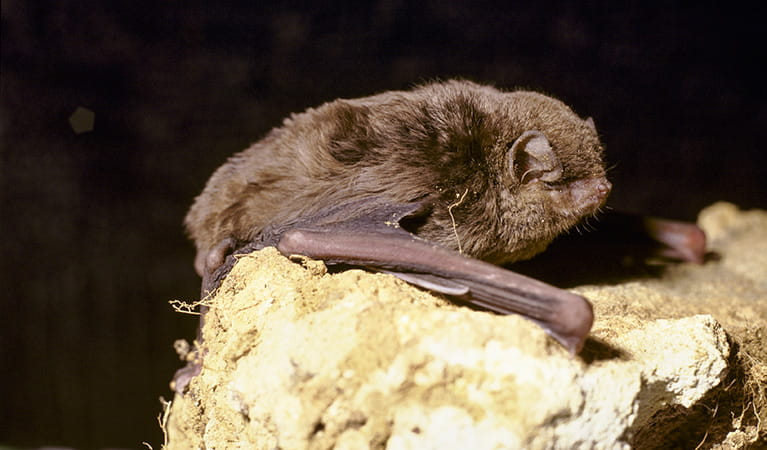
Eastern bentwing-bat (Miniopterus schreibersii oceanensis)
Eastern bentwing-bats congregate in caves across the east and north-west coasts of Australia, in colonies of up to 150,000. These small Australian animals weigh around 13-17g and can reach speeds of up to 50km per hour. Eastern bentwing-bats use both sight and echolocation to catch small insects mid-air.
-
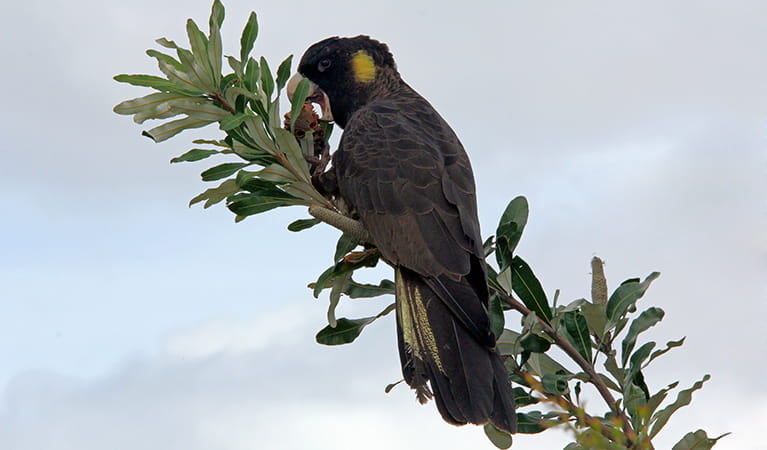
Yellow-tailed black cockatoo (Calyptorhynchus funereus)
The yellow-tailed black cockatoo is one of the largest species of parrot. With dusty-black plumage, they have a yellow tail and cheek patch. They’re easily spotted while bird watching, as they feed on seeds in native forests and pine plantations.
-

Common ringtail possum (Pseudocheirus peregrinus)
Commonly found in forests, woodlands and leafy gardens across eastern NSW, the Australian ringtail possum is a tree-dwelling marsupial. With a powerful tail perfectly adapted to grasp objects, it forages in trees for eucalypt leaves, flowers and fruit.
-
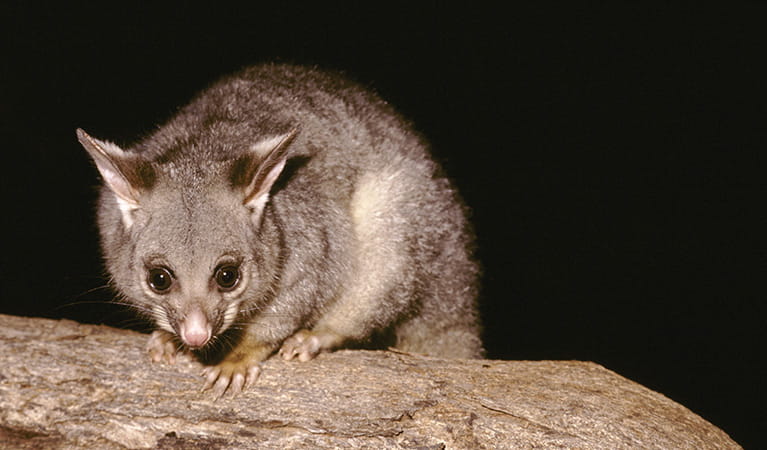
Common brushtail possum (Trichosurus vulpecula)
One of the most widespread of Australian tree-dwelling marsupials, the common brushtail possum is found across most of NSW in woodlands, rainforests and urban areas. With strong claws, a prehensile tail and opposable digits, these native Australian animals are well-adapted for life amongst the trees.
-
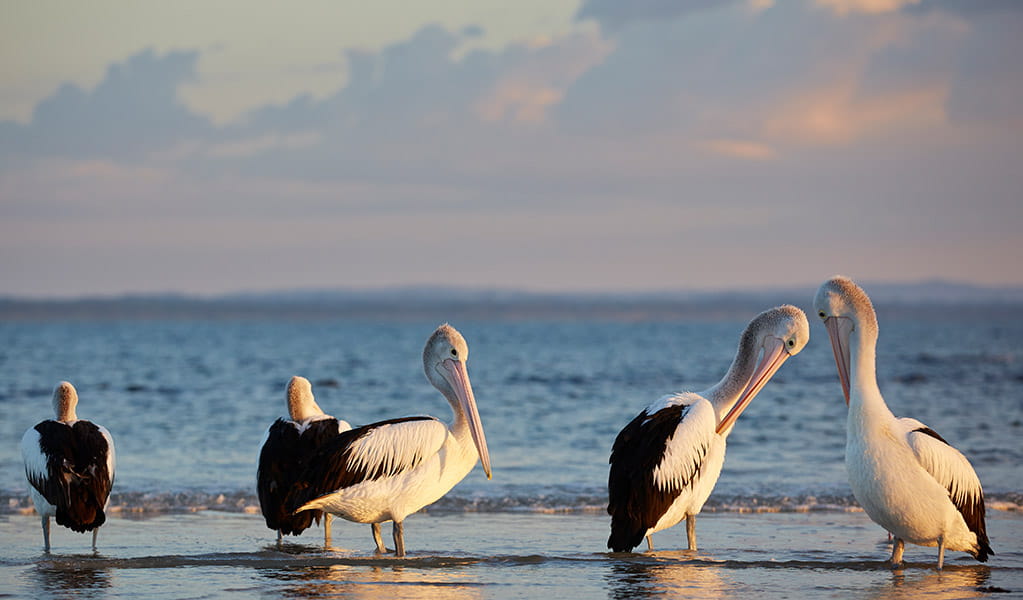
Australian pelican (Pelecanus conspicillatus)
The curious pelican is Australia’s largest flying bird and has the longest bill of any bird in the world. These Australian birds are found throughout Australian waterways and the pelican uses its throat pouch to trawl for fish. Pelicans breed all year round, congregating in large colonies on secluded beaches and islands.
-
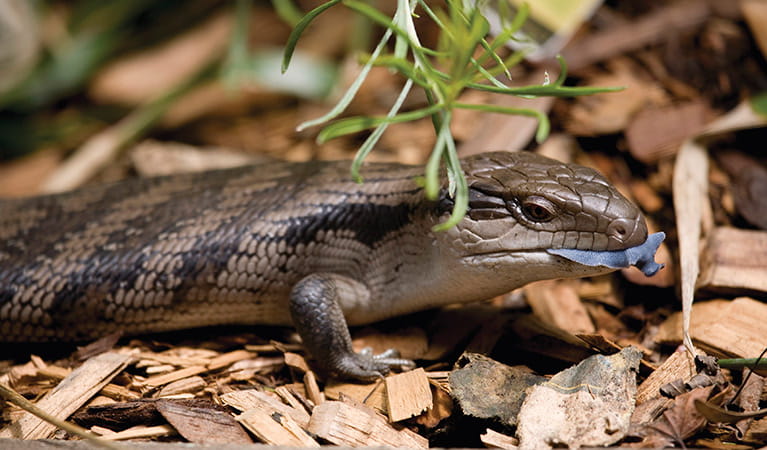
Eastern blue-tongue lizard (Tiliqua scinciodes)
The eastern blue-tongue lizard, one of the largest skinks in Australia, is found throughout most of NSW. When threatened, the eastern blue-tongue lizard displays its blue tongue in a wide-mouthed intimidating show. Not an agile animal, they feed on slow-moving beetles and snails.
-
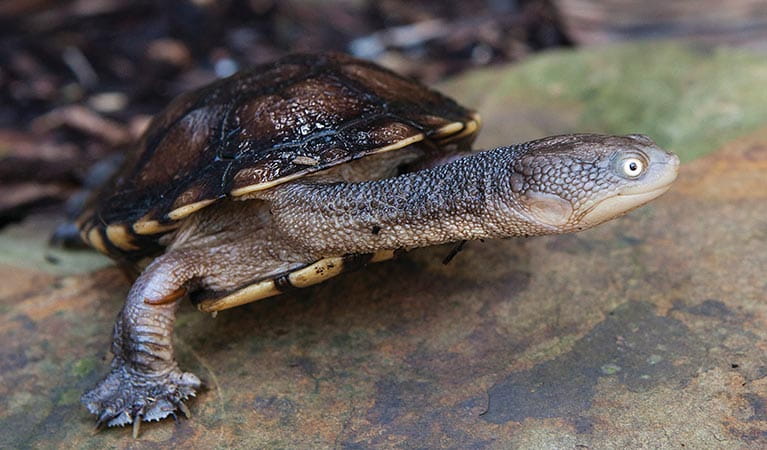
Eastern snake-necked turtle (Chelodina longicollis)
Found across most of NSW, the eastern snake-necked turtle, also known as the eastern long-necked turtle, can be found in swamps, lakes and inland waterways. This freshwater turtle is carnivorous and lives most of its life submerged on the water’s edge, searching for worms and snails.
-
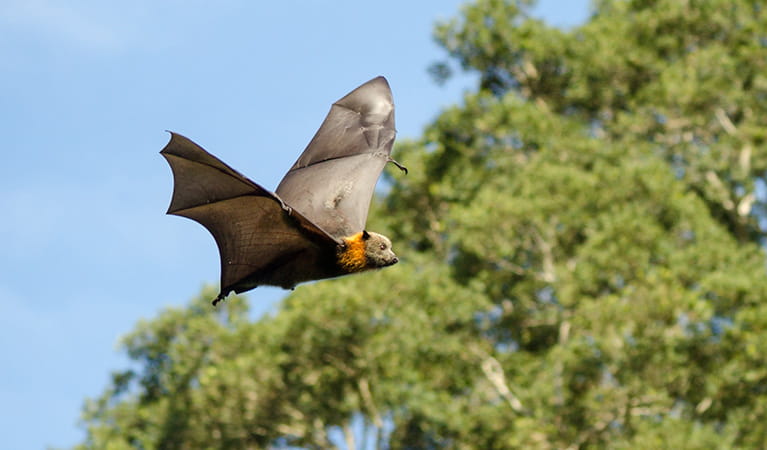
Grey-headed flying-fox (Pteropus poliocephalus)
The grey-headed flying fox is Australia's largest native bat, with a wingspan up to 1m. This threatened species travels up and down south-eastern Australia and plays a vital role in pollinating plants and spreading seeds in our native forests.
-
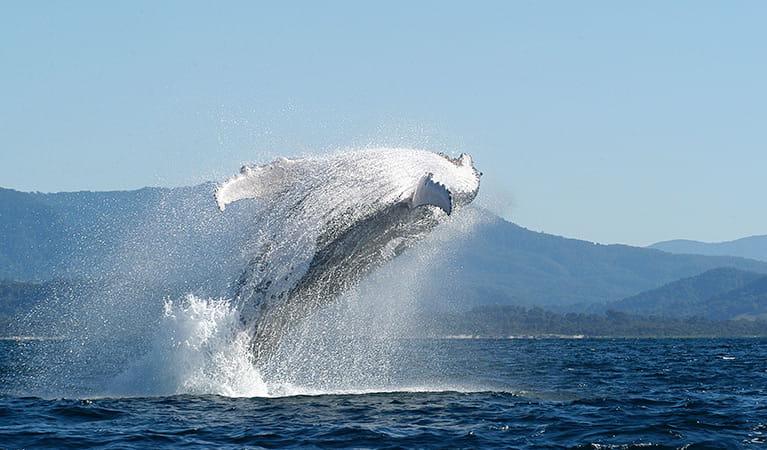
Humpback whale (Megaptera novaeangliae)
The humpback whale has the longest migratory path of any mammal, travelling over 5000km from its summer feeding grounds in Antarctica to its breeding grounds in the subtropics. Its playful antics, such as body-rolling, breaching and pectoral slapping, are a spectacular sight for whale watchers in NSW national parks.
-
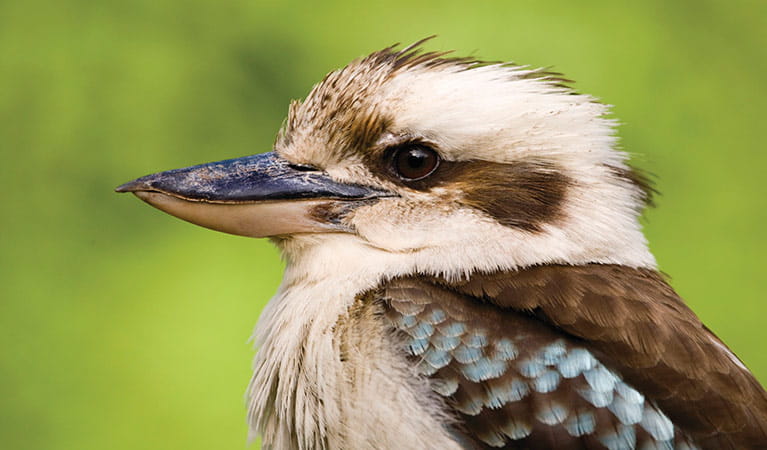
Kookaburra (Dacelo novaeguineae)
Of the 2 species of kookaburra found in Australia, the laughing kookaburra is the best-known and the largest of the native kingfishers. With its distinctive riotous call, the laughing kookaburra is commonly heard in open woodlands and forests throughout NSW national parks, making these ideal spots for bird watching.
-
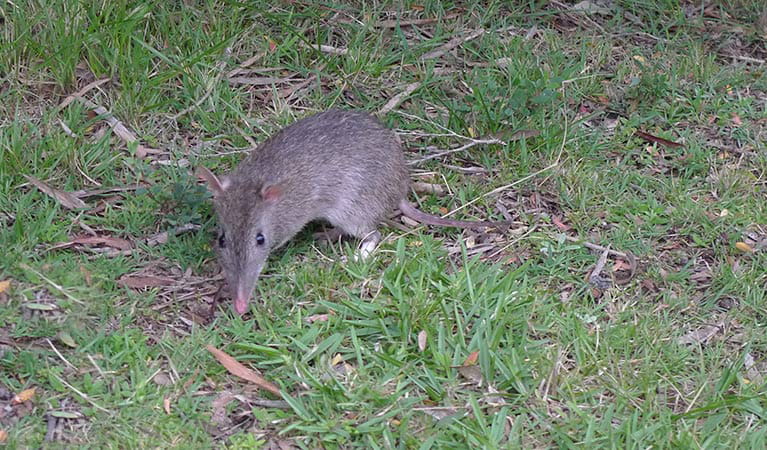
Long-nosed bandicoot (Perameles nasuta)
A nocturnal marsupial and one of the smaller Australian native animals, the long-nosed bandicoot is found across eastern Australia. Populations in the Sydney region have dwindled since European settlement, leaving only endangered colonies in inner western Sydney and at North Head, near Manly. The long-nosed bandicoot has grey-brown fur and a pointed snout which it uses to forage for worms and insects.
-
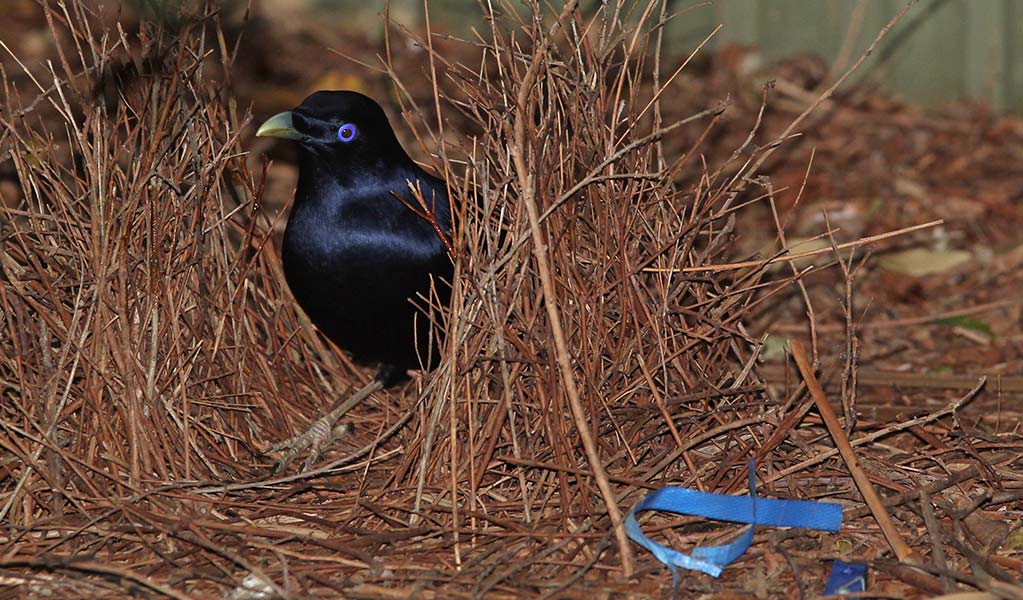
Satin bowerbird (Ptilonorhynchus violaceus)
With vibrant blue-violet eyes and curious antics, the satin bowerbird is a favourite for bird watching and easy to spot as it forages for food in open forest. Relatively common across eastern Australia, in NSW they’re found in coastal rainforests and adjacent woodlands and mountain ranges.
-
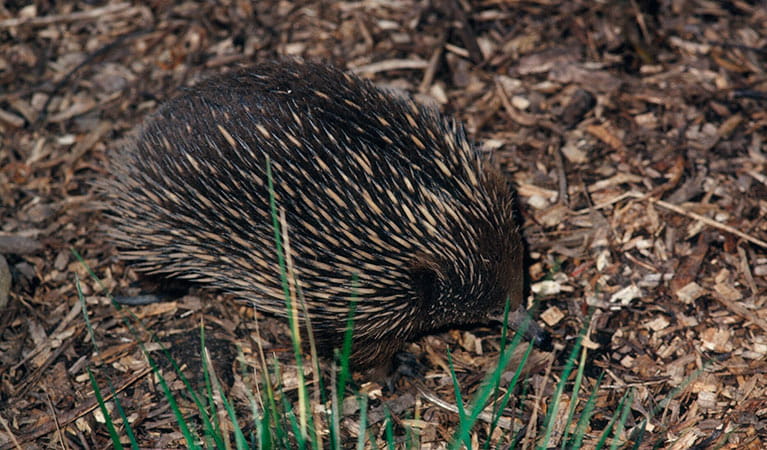
Short-beaked echidna (Tachyglossus aculeatus)
One of only 2 egg-laying mammals in the world, the short-beaked echidna is one of the most widespread of Australian native animals. Covered in spines, or quills, they’re equipped with a keen sense of smell and a tube-like snout which they use to break apart termite mounds in search of ants.
-

Southern boobook (Ninox novaeseelandiae)
The southern boobook, also known as the mopoke, is the smallest and most common native owl in Australia. With a musical 'boo-book' call that echoes through forests and woodlands, the southern boobook is a great one to look out for while bird watching.
-
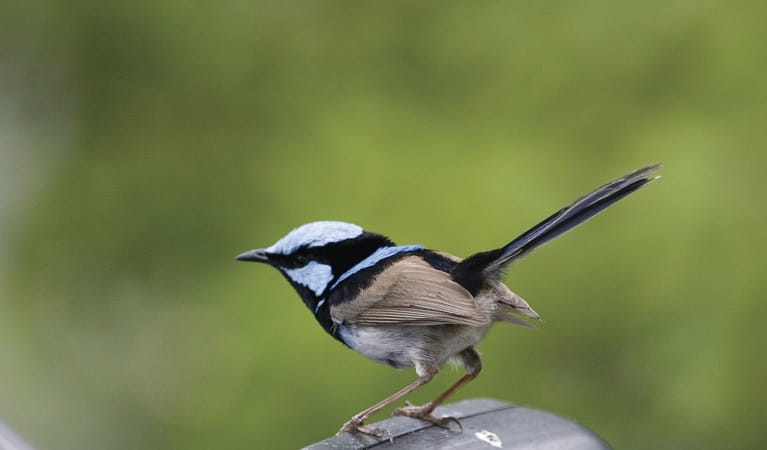
Superb fairy wren (Malurus cyaneus)
The striking blue and black plumage of the adult male superb fairy wren makes for colourful bird watching across south-eastern Australia. The sociable superb fairy wrens, or blue wrens, are Australian birds living in groups consisting of a dominant male, mouse-brown female ‘jenny wrens’ and several tawny-brown juveniles.
-

Swamp wallaby (Wallabia bicolor)
The swamp wallaby, also known as the black wallaby or black pademelon, lives in the dense understorey of rainforests, woodlands and dry sclerophyll forest along eastern Australia. This unique Australian macropod has a dark black-grey coat with a distinctive light-coloured cheek stripe.
-
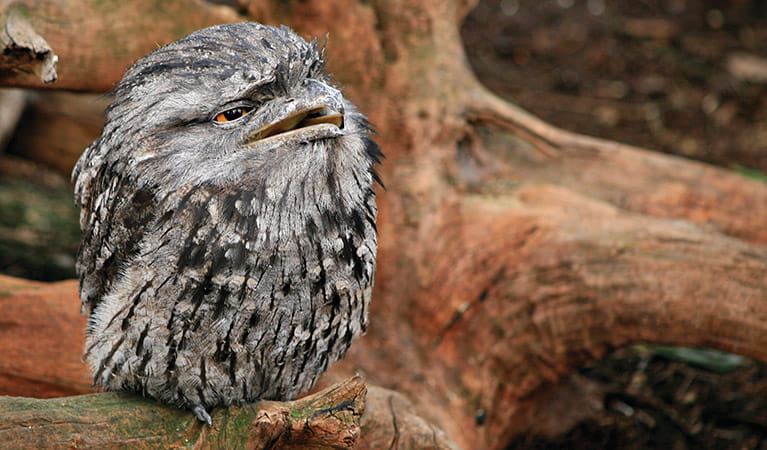
Tawny frogmouth (Podargus strigoides)
Found throughout Australia, the tawny frogmouth is often mistaken for an owl due to its wide, powerful beak, large head and nocturnal hunting habits. The ‘oom oom oom’ call of this native bird can be heard echoing throughout a range of habitats including heath, woodlands and urban areas.
-

White-bellied sea eagle (Haliaeetus leucogaster)
White-bellied sea eagles can be easily identified by their white tail and dark grey wings. These raptors are often spotted cruising the coastal breezes throughout Australia, and make for some scenic bird watching. Powerful Australian birds of prey, they are known to mate for life, and return each year to the same nest to breed.
Plants
-
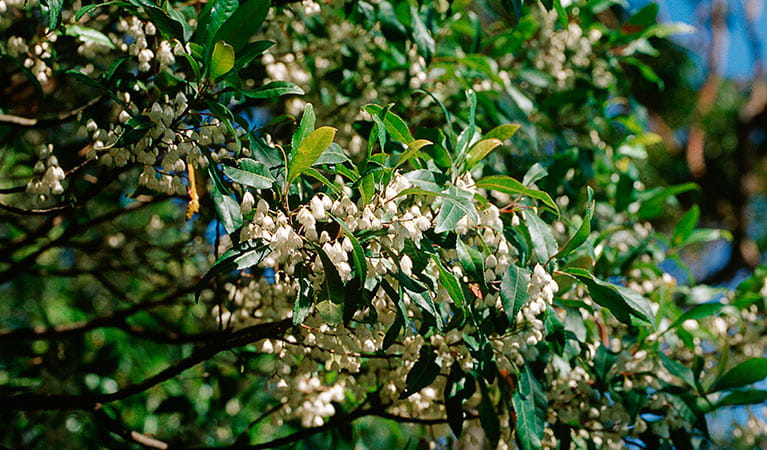
Blueberry ash (Elaeocarpus reticulatus)
The blueberry ash is a rainforest shrub which produces blue olive-shaped berries and spectacular bell-shaped flowers, which often appear on the plant together. It is a tall slender shrub or small tree found in rainforest, tall eucalypt forest and coastal bushland in eastern NSW, south-east Queensland and Victoria.
-
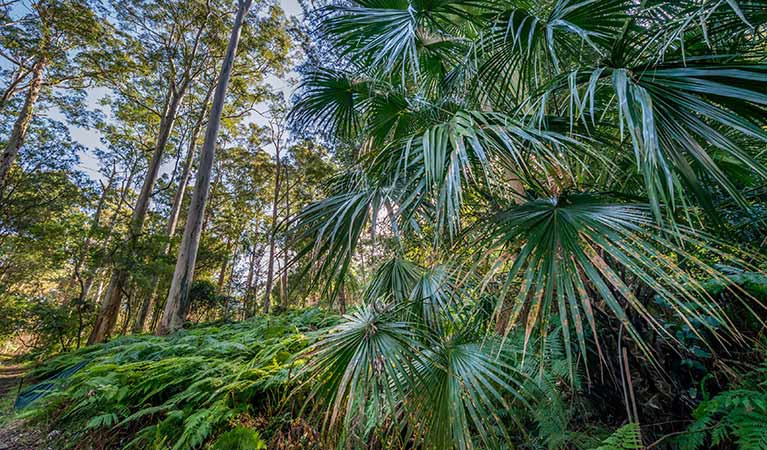
Cabbage palm (Livistona australis)
With glossy green leaves spanning 3-4m in length and a trunk reaching a height of up to 30m, the cabbage tree palm, or fan palm, is one of the tallest Australian native plants. Thriving in rainforest margins along the east coast of NSW, in summer this giant palm produces striking spikes of cream flowers which resemble cabbages.
-
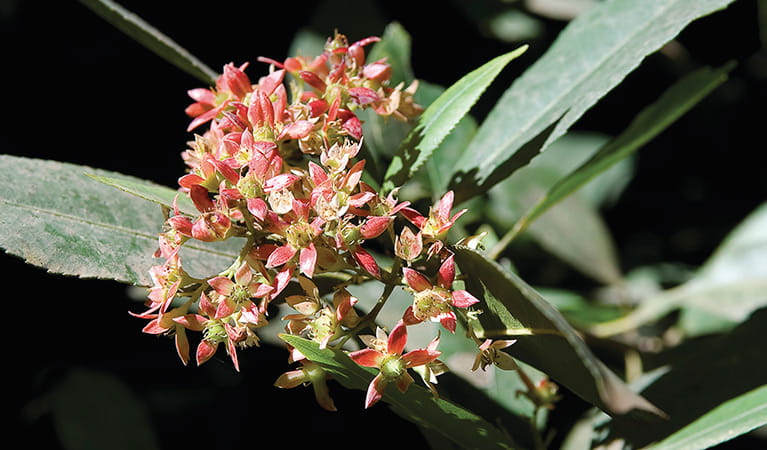
Coachwood (Ceratopetalum apetalum)
Coachwood trees are Australian native plants that grow in warm temperate rainforests along coastal NSW. Also known as scented satinwood, the mottled grey bark of the coachwood has horizontal markings and a delicate fragrance.
-
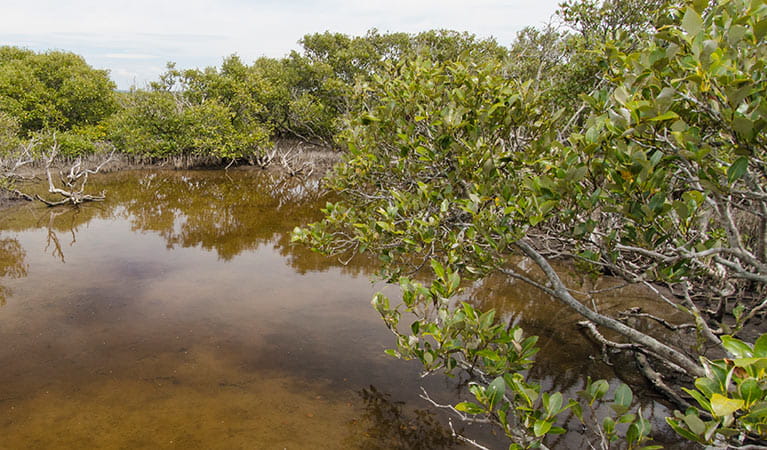
Grey mangrove (Avicennia marina)
Grey mangrove is the most common and widespread mangrove found within intertidal zones across Australia, and throughout the world. Growing to a height of 3-10m, they thrive best in estuaries with a mix of fresh and salt water. They excrete excess salt through their long thick leaves, and absorb oxygen through their aerial root system.
-
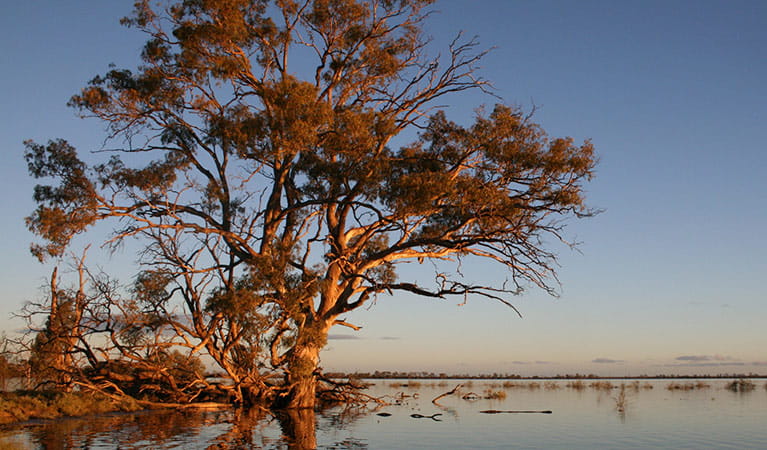
River red gum (Eucalpytus camaldulensis)
Australian native plants, majestic river red gum trees are widespread across Australian inland river systems. The river red gum is a dominant tree species of the Murray-Darling basin which spans NSW, Queensland and Victoria. This iconic native eucalypt grows to a height of 30m and is thought to have a lifespan up to 500-1000 years.
-
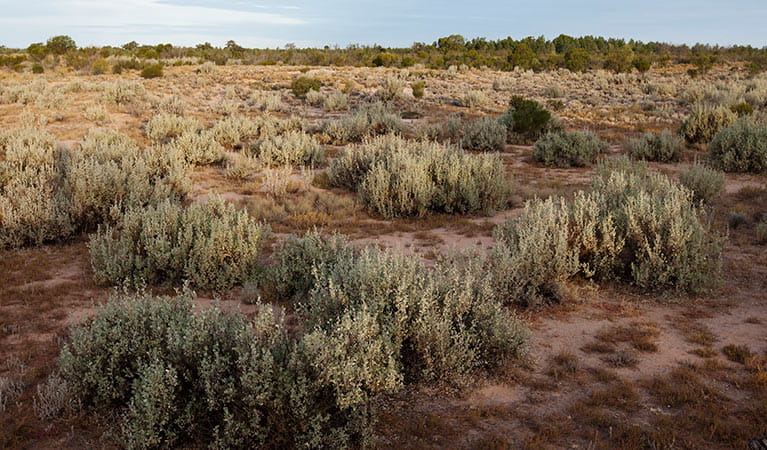
Saltbush (Atriplex nummularia)
A hardy Australian native plant, the saltbush is a small spreading shrub that can withstand dry salty soils such as those found in the desert plains of western NSW. It is grey-white in colour and has small spear-shaped succulent leaves. It flowers from December to April.
-

Saltbush (Atriplex nummularia)
A hardy Australian native plant, the saltbush is a small spreading shrub that can withstand dry salty soils such as those found in the desert plains of western NSW. It is grey-white in colour and has small spear-shaped succulent leaves. It flowers from December to April.
-
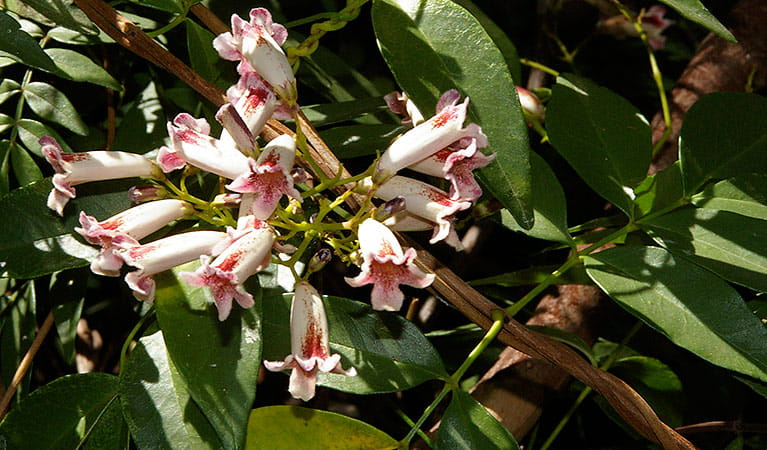
Wonga wonga vine (Pandorea pandorana)
The wonga wonga vine is a widespread vigorous climber usually found along eastern Australia. A variation of the plant occurs in the central desert, where it resembles a sprawling shrub. One of the more common Australian native plants, the wonga wonga vine produces bell-shaped white or yellow flowers in the spring, followed by a large oblong-shaped seed pod.

